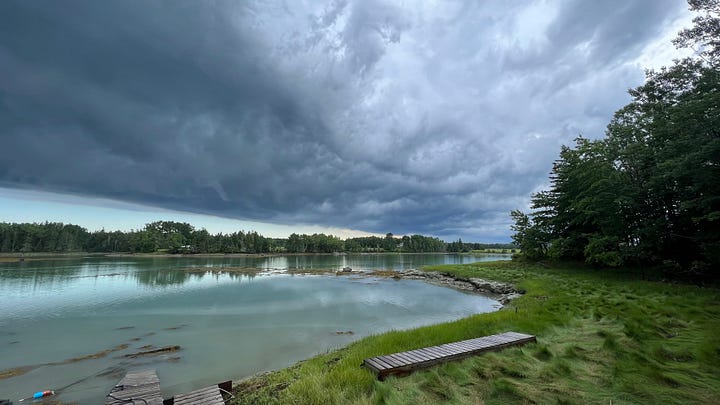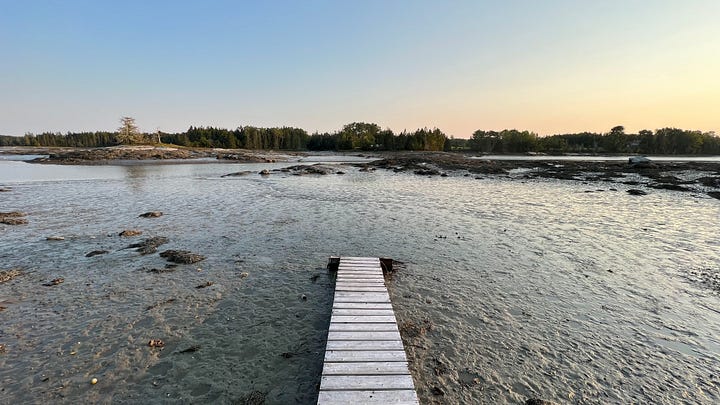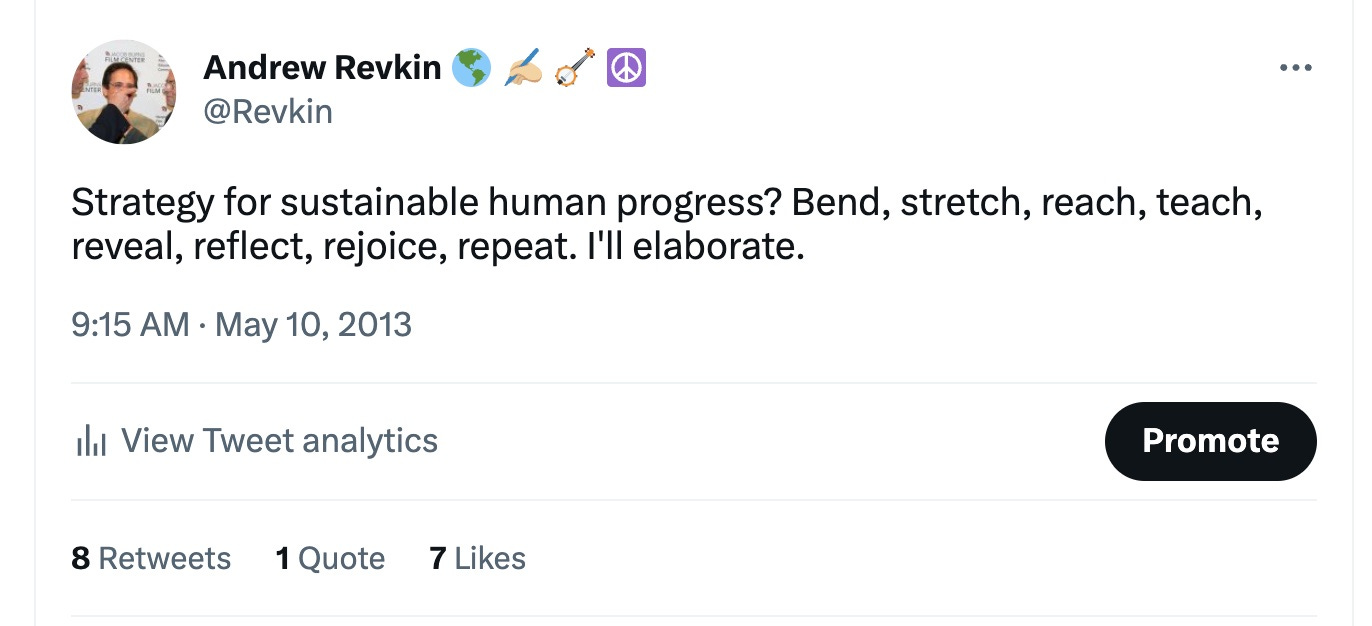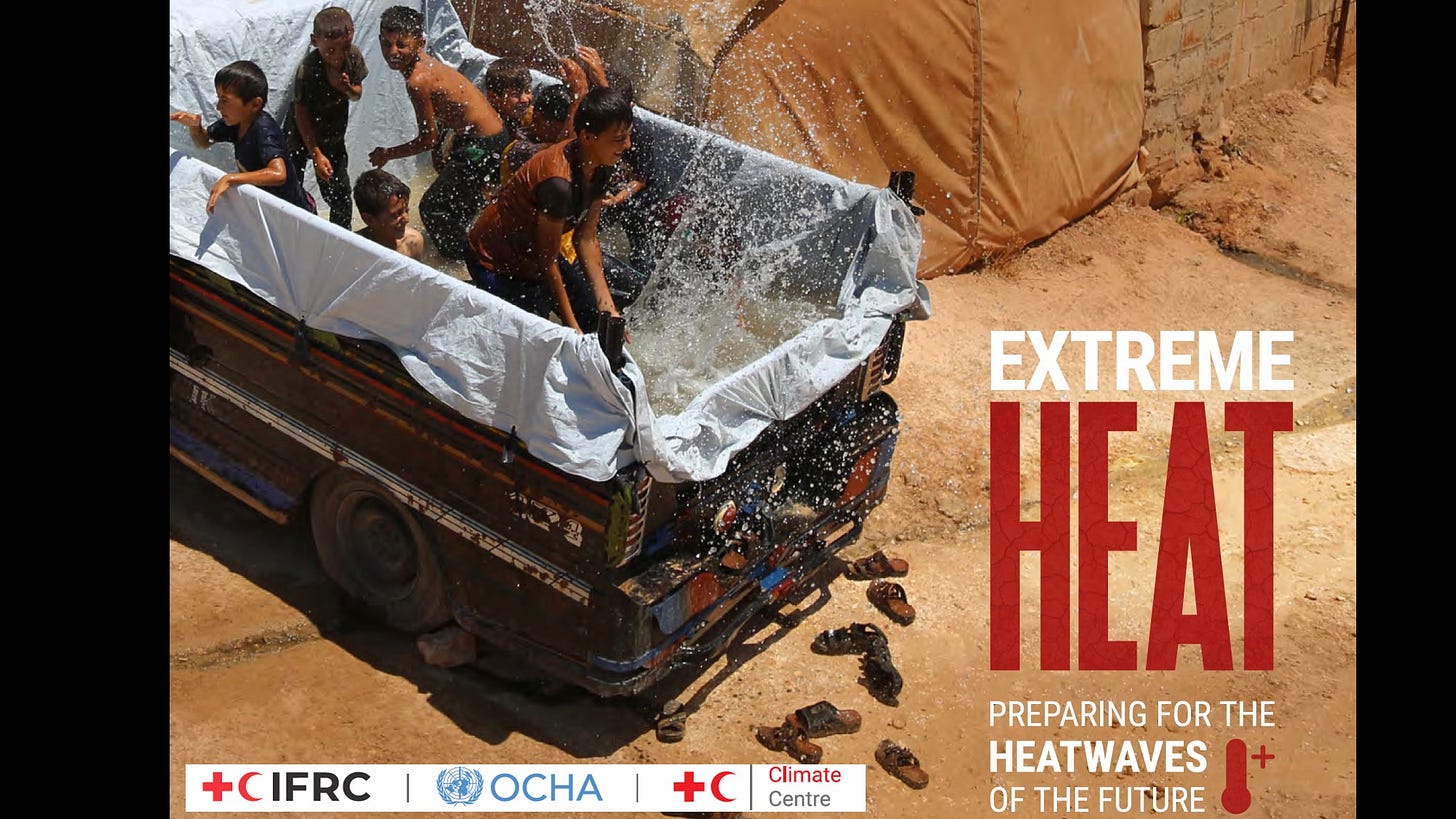How to Defeat the Climate Change Complexity Monster
Use key questions to cut amorphous slogans like "climate emergency" into addressable pieces.
The University of Bergen in Norway has just wrapped a valuable two-day conference on “Living With Climate Change.”
The core focus? How to handle what seems like a deep contradiction: “While there is broad agreement on the urgent need for action to mitigate climate change, people must also go on living their daily lives, attending to their needs and interests of themselves, their families and their community.” (The first day stream is here. Review highlights from Twitter via #climlifebergen.)
I was honored to be invited to give an opening keynote talk but couldn’t attend. This wasn’t just to cut down on flying; my older son just got married in Nashville. So I recorded the talk on our Maine coastline beforehand. Here’s the video, followed by the transcript, which includes an added section exclusively available to you, the Sustain What community.
I’m calling the talk How to Dismantle the Climate Change Complexity Monster.
~ ~ ~
Greetings. I couldn’t think of a better way to explore the conference theme from a distance than to start on our little patch of waterfront in Wabanaki territory in Maine.
After 30 years in the Hudson River valley north of New York, My wife and I moved here last year in part to be near her mom, who was born in a nearby lobster village nearly 91 years ago and still lives there. Along with you and the other 8 billion people alive now on this planet, we are living with climate change here.
That implicitly comes with coastal change. We live on a tidal inlet. Local tides rise and fall about three meters on average. Occasional king tides take that up close to four meters.


Storm surge as time machine
Add a wicked storm surge to a king tide and you’re probably looking at the average high tide late in this century. That’s what happened here on December 23rd. The dock our predecessors built in the 1970s is history.
That high-tide storm was essentially a time machine. Given what’s coming, we’re almost assuredly not rebuilding that dock. The fringing salt marsh will be better for it as well. But I embraced buying our home, which is five meters above the average high tide, despite knowing seas are rising and will be doing so for many centuries to come, despite knowing that Greenland and Antarctic glaciers show signs of instability.
After 35 years on the climate change beat, including dozens of interviews over decades with the best experts, my bet is that this funky cottage, built of local logs in the 1970s, will be fine through 2070 or so at least. At that point, our sons can raise it, move it or move on.
Of course, that’s a privileged position to be in. Around the world, I’ve reported for decades from regions where the capacity to deal with climate hazards and change is far more limited - Kenya, India, small island nations, the Amazon, coastal Louisiana.
So what policies and personal choices can help as many people as possible live with climate change? What can we do to help societies build a sustainable human relationship with climate and coasts, energy and ecosystems, and each other?
There are two main tracks: Cut climate vulnerability by spreading the capacity to adapt to those most in harm’s way. Slow the pace of climate change by cutting CO2 and the rest of the greenhouse gases.
We know how to do both of course. It was all in articles I’ve written since 1988 and every IPCC report from then forward.
But as Connie Hedegaard will explore in the meeting, we know we're good at setting targets and less good at achieving them. That's kind of an understatement. She'll be exploring whether we can manage our systems, organizations and behavior as fast as is needed.
To me, the answer is we'll never change as fast as needed.
And that's not a failure. It's just being human.
Our capacity to harness energy in ways that change the climate built far faster than our capacity to understand the full implications and pathways out of this bind.
What would be a failure is not to wake each day and try to make progress.
It can be depressing, even paralyzing, to see targets come and go. A decade ago, I began a Twitter string when I fully recognized the limits of numbers. Targets like 2 degrees, 1.5, 350. You name it.
When I grappled with that question - what do you do, what do you work on? - I found then and now that the best way past that sense of paralysis is to pick apart the “complexity monster” called the climate crisis or climate emergency.
Those terms are way too vague and vast to be meaningful. Pick them apart. Use a tool that the best journalists have employed for generations: the question mark.
When someone shouts climate emergency, ask who is in a state of emergency? Why? What are the drivers of risk? What factors can be addressed to reduce harm and loss?
For every climate threat, there's a set of answers and a job to do.
Beat the heat
The world faces growing zones of truly dangerous heat waves beyond modern experience, beyond survivability, according to some basic physiological calculations. I interviewed Kristie Ebi at the University of Washington, who's one of the world's leaders on climate and health and heat. And she has said this to me over: “Nobody needs to die in a heat wave.” Listen to her:
Ebi: There has been, for very good reasons, a primary focus on mitigation, reducing our greenhouse gas emissions. We have to adapt. People are suffering and dying right now from climate change, including from heat. All of those deaths are potentially preventable. Nobody needs to die in a heat wave. So the people who are suffering and dying right now, if we had really good heat action plans, if we were taking steps to help protect these people, we could reduce morbidity and mortality right now. And as you've written about so much, Andy, the future is in our hands. The temperatures we're going to see in the next couple of decades depend on our actions, on what we will do, what we do individually and collectively to reduce our emissions.
What she has laid out is the importance of looking around your community. Down the street from you, who doesn't have an air conditioner? Where are the elderly people who are not on the Internet who need to be alerted when extreme heat is building? There are action points all around. The same for floods, the same for storms.
As Extreme Storms Strike Again, It's Time to Shake out Community Climate Vulnerabilities
🌧️ Please subscribe (free of charge) to this Sustain What newsletter - my journalistic journey building a cooler relationship between people, our planet and each other, one post at a time. ⛈️ One core theme is identifying steps that cut societal risk when the worst happens - whether the hazard is in the air, water or under our feet.
We can do huge amounts of resilience building at the local level. And then at the global level, of course, organizations and institutions - academia, where I sit part of the time - have a huge amount of responsibility for making sure that information is available in a timely fashion and in fashion in ways that fit the local ecosystem of action.
Who needs to know when the flood is coming? How do you make that case? How do you make sure the right media are involved? Those are questions beyond the traditional forms of journalism that I grew up with. And they're all part of how we get through this process toward a more resilient world that is living with climate change, even as we're working to slow climate change.
What about that rising CO2?
The carbon problem is the ultimate problem, and it's going to take time. There are many countries in this planet, and communities, that are under energized. It’s immoral for the rich world to say to Ghana or Mozambique, you can't have your fossil fuels when we've developed all of our wealth and technology and advancement using them for more than a century. Finding ways to accommodate growth in some fossil fuel use where it's needed, where it's the only option, is part of the answer to the climate problem. It seems hard to figure out sometimes, but it's really true. One of the things you have to live with to live with climate change – is living with contradiction. Not everyone will be on the same plan, the same timetable. [Watch a highly relevant Sustain What conversation on energy equity and climate justice.]
Shift the focus from climate change to climate risk
Along with the question mark, I'd love to offer one more tool and tactic that I found invaluable in cutting to the core of a climate challenge. Try substituting the phrase climate risk for climate change every time it comes up in conversation, in a speech, in your own mind when confronting the challenge you face.
Climate change meaning changes in hazards like storms and heat waves linked to rising greenhouse gases. But that is just one driver of the climate risk facing a community. Societal conditions - inequity, marginalization, exclusion from decision making - are far bigger factors still and more addressable on short timescales. This is all in the IPCC reports (working group 2). I'll never forget the fantastic distillation of this idea offered by the great climate-focused geographer Diana Liverman, who recently retired at the University of Arizona after decades of groundbreaking research and service on IPCC reports.
Liverman - When we talk about climate risk, some people still just think, “Oh, it's the probability of a heat wave.” But we need to think about risk not as the probability of the heatwave, but as the probability of harm.
In addition to population growth and other factors, poverty is massively important in explaining vulnerability. Even though we’ve brought millions of people out of poverty, there are parts of the world where aspects of poverty make people very vulnerable. The work we've done in Mexico and in other regions shows that if you’re poor and they privatize your water, it makes you more vulnerable. If you're an indigenous community and somebody steals your land, you're vulnerable. There are so many ways in which addressing basic social welfare can reduce vulnerability, whether it's in New Orleans or Mexico City.
Of course, identifying climate vulnerability is just the first step to eliminating it. That requires a commitment in people at every level to working in a sustained way to overcome longstanding injustices and institutional barriers to spreading resilience to all. There's a lot of inertia out there.
This is where a personal stocktaking comes in handy.
What are your skills and passions? Are you an artist, engineer, journalist, electrician, teacher? What gaps can you fill by building networks, reaching out to others with other skills if you can't do it all yourself – and you can’t. Focus on identifying hotspots of vulnerability, down the block or around the world. The Internet makes that possible.
For energy opportunity, it’s the same. (In the United States, with our trillion dollars in opportunity money, there's tons to do.)
And then dive in at whatever scale suits you best to make incremental but measurable progress. Individual action has been much derided of late by those correctly noting that industries dead set on maintaining the fossil fuel status quo tried for decades to sell us the narrative that everything from litter to global warming is not their fault.
Individual action has been attacked by others correctly, because we all know that what is needed is system change, not light bulb change.
But what is the path to system change? A transformative movement starts through a thousand dispersed, individual experiments, campaigns and tests on the ground.
Some are in courtrooms. Go to OurChildrensTrust.org for one. Some are technological. Look at Myheat.ca for an interesting visualization of energy change in neighborhoods. Some is social - yes, including protests like Fridays for Future. Some are educational. Go on a boiler room tour. [Click here for some of what I’ve written about this kind of place-based education.] Some opportunities are legislative. The Green New Deal had its flaws, but the great ideas in it live on as a framework for equitable and systematic climate action.
Paths From Classrooms to Climate Impact Include Taking a Field Trip to the Boiler Room
Please SUBSCRIBE to receive my posts by email. Program note 📺 - If schools aren’t safe, forget about climate education. Join me Friday March 10 at noon Eastern time to meet amazing people working to boost the resilience and readiness of hundreds of thousands of schools in earthquake hot spots, from Oregon to Indonesia, Turkey to Nepal, Haiti to China.
And I do think communication experiments can play a role. The first 20 years of my global warming reporting from 1988 through 2007 were mostly explanatory science and policy journalism: me, the reporter, telling stories to you, the audience, using a widening array of tools. It was really cool and fun. But what happened in the meantime? A lot of emissions.
Hundreds of journalists have migrated to the climate beat and many are doing essential and innovative work. But I wouldn't count on news coverage tipping some balance, and not just because fossil fuelers have dumped hundreds of millions of dollars into ad campaigns and buying political influence. Media, particularly in the Instanet age, are simply not well set up to address wicked problems like this one.
Great reporting is still happening. But overall, I see the greatest potential for communication impact in moving from telling a better story - my stock in trade for decades - to fostering more productive conversations and connectedness: connecting all those changemakers distributed across the world to make a difference.
This can occur within communities to foster resilience and clean-energy access and between communities to share successes and failures.
That's where social media really can matter no matter what Elon Musk does. Two examples that excite me are the hashtag #skypeascientist, which started back in the days when Skype was the thing instead of Zoom, but still lives on. It's a way for scientists to connect with communities, with educators, libraries, other groups.
Thriving Earth Exchange is an innovative effort by the American Geophysical Union to connect hydrologists, geologists, other earth scientists and atmospheric scientist with communities facing challenges.
Here’s a relevant Sustain What webcast and conversation:
With Billions of Dollars to Invest in Clean Energy and Resilience, Here's the New Climate Communication Challenge
I'm grateful that I was invited to join a Climate Week panel on a critical question: With hundreds of billions of dollars poised to flow to clean energy and climate resilience projects in the United States, what new approaches to climate communication are needed?
Diversity - inevitable, desirable, uncomfortable?
There's something about facing a climate challenge involving a shared atmosphere that seems to make us feel like we all need one path. But I've learned living with climate change is living with difference.
The prismatic complexity of climate change is what makes it so challenging to address. But it also means everyone can have a role in charting a smoother human journey. I've come to see the diversity of human temperaments and societal models and environmental circumstances and skills as kind of perfect for the task at hand. You don't think of us as perfect, but in our imperfection and complexity, I think we're kind of well situated for solving this challenge in a very human way.
If we were all Greta Thunberg or Bill Gates, I think we'd be in trouble. You may resist that thought, but roll it around in your head and see what you think. Let me know.
Google for the phrase “response diversity” and my name for some social science on this.
Thomas Elmqvist over in Stockholm led a group in 2003 that did a fundamentally important paper on response diversity in ecosystems as a source of resilience. I contend the same is true for social systems. We need edge pushers and group huggers, faith and science, and - more than anything - dialogue to find room for agreement, even when there are substantial differences.
At the level of nations and cultures, a diversity of approaches is also inevitable. And that's why the shift in climate diplomacy - away from what I reported on for almost 20 years, a binding top-down model, a contract for climate - to a flexible but credible and inclusive agreement, the Paris Agreement, is a perfectly human version of success.
Of course, it's deeply inadequate. But as I said earlier, inadequacy is us. Finding ways to deal with that, to work with it, is important.
Insert - After I gave the talk I noticed there’s a brand new paper from Elmqvist and a heap of co-authors that takes the response diversity concept directly into the arena of sustainability policy: Response diversity as a sustainability strategy. Here’s an illustration:

I plan to have Elmqvist and others in a Sustain What discussion soon! - End insert
What’s love got to do with it?
There's one other element here, and it's values and even love.
This came up for me as a science writer in a very unusual setting - at the Vatican in 2014. I was there for a meeting that predated and provided a foundation for the Pope's Encyclical, which came out in 2015 - the Encyclical in which he, by the way, stressed the importance of accommodating diversity, through dialogue. This meeting at the Vatican was on sustainable humanity, sustainable nature, our responsibility - right at the core of what you're thinking about at this meeting.
There were sessions for days on everything from practical matters like food, agriculture and the Anthropocene to existential risk. It was overwhelmingly rich and interesting and challenging. After dinner on the final evening, I turned to Walter Munk. At the time, he was 96. He was a Scripps Institution oceanographer who was legendary for decades for doing leading-edge science. He played a role back in World War Two in helping allied amphibious invasions succeed by refining models for waves and storms so we could predict when would be a good day to hit the beaches.
So here's this guy - a physical oceanographer, a numbers person – and I asked him, “What do you think it'll take for humanity to have a smooth journey in this century?”
And Walter didn't mention science or technology, carbon capture, a carbon tax, fusion power, political will. He turned to me without hesitation and said, “This requires a miracle of love and unselfishness.”
And my hair stood on end in the most beautiful way. I was just blown away by the utterly human magic in that reply. I wish I had taped it so you could hear it in his own words. But those are mine.
Please offer reactions, critiques, questions!

















Intense article with positive, alternate ways of doing and thinking that hit me in my heart and mind. Hitting me right where I needed something, anything, to stop me tearing my hair out about the intransigence of people. After I surfaced from my battle with blood cancer, chemo and the rest, I was so happy to have survived. The next minute, so down-cast about the stubborn head-in-the-sandery of politicians, their fossil-fuel lobby groups, and the supposed Great Australian Public. I've been dithering, what can I do? What can I do? A bit clearer now. To start, I'll study this article and the links. Spread this new way of thinking in my circles. Then ... well, I've got a direction now.
I'm not exactly sure how I found my way to this particular blogpost, but I'm glad I did.
It is powerful and inspirational for me on a couple different levels. A couple quotes spoke to me,
“One of the things you have to live with to live with climate change – is living with contradiction. Not everyone will be on the same plan, the same timetable.”
and
"What would be a failure is not to wake each day and try to make progress.”
I am a retired fusion research engineer and have developed a passion for climate change science and policy. I follow the likes of Zeke Hausfather, Hannah Ritchie, Jessie Jenkins, and Jessica Tierney to name a few. Even on their blogs where you think you might find like minded people there is contradiction and controversy, but inspite of that, I find their messages hopeful and consistent.
The other thing that spoke to me was my personal connection to Norway and Bergen. . All of my ancestors are from Norway and most of them emigrated from Norway to America in the 1840s and 1850s. In fact, one set of great-great grandparents sailed from Bergen in 1844.
As for contradictions, Norway is a climate change contradiction unto itself. It has derived much of its wealth from North Sea oil and gas, and yet is one of the greenest countries in terms of energy generation (almost all hydroelectric) and leader in adoption of electric vehicles. We visited there in 2019, Oslo and surrounding areas including the Vermork Hydroelectric museum and nearby Rollag, the homeland of mother's ancestors.
I think we all wish we could somehow make more of difference but yet you are so right that we need to live our lives and not get overwhelmed. Never give up. Never surrender.